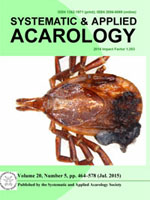The movement of ticks into North America has occurred for many years, due to the importation of exotic reptiles and mammals (Becklund 1968; Keirans and Durden 2001) as well as through the annual spring migration of birds from South and Central America (Scott et al. 2001; Hamer et al. 2012; Mukherjee et al. 2014). The focus of this paper is on the discovery of an adult female Amblyomma longirostre (Koch, 1844) in Oklahoma, an exotic tick normally reported on birds and mammals in South and Central America.
On 24 September 2005, a homeowner discovered a large, odd looking tick crawling on a propane tank in Pittsburg County, south of Hartshorne, Oklahoma. The tick was collected, brought to the Pittsburg County Oklahoma Cooperative Extension Service office where it was sent by mail to the Plant Disease and Insect Diagnostic Lab (PDIDL) in the Department of Entomology and Plant Pathology at Oklahoma State University. The tick was identified on 3 October 2005 using an established key (Jones et al. 1972) (Figs 1, 2) as an adult female A. longirostre and given an ascension number (#200501316). It was later verified using detailed descriptions by Voltzit (2007).
Amblyomma longirostre is native to South and Central America (Voltzit 2007) and is associated with a variety of bird and mammal species (Nava et al. 2010), including porcupines. There have only been 4 reports of this tick feeding on humans (Guglielmone et al. 2006; Nava et al. 2010). In North America, A. longirostre have been reported in Pennsylvania (Jones et al. 1972), Tennessee (Durden and Kollars 1992), Michigan (Becklund 1968), Illinois (Hamer et al. 2012), and Canada (Scott et al. 2001). All reports have been larval and nymphal ticks on migrating passerines except for Michigan where an adult male was discovered on an exotic porcupine being imported into Detroit (Becklund 1968). Most notably, Scott et al. (2001) discovered two A. longirostre larvae on a Traill's flycatcher in Delta, Manitoba, a distance of at least 5,000 km from where it began its migration. Oklahoma is in the central portion of the Central fly way, receiving many species of birds from Central and South America (FWS 2012).
The discovery of an adult female A. longirostre collected off a host is noteworthy and the time of discovery in late September may provide a clue as to the timeline of events. Immature A. longirostre are normally found on birds in North America during the spring migration period from Central and South America (Hamer et al. 2012; Scott et al. 2001; Mukherjee et al. 2014). Several studies have reported finding engorged nymphs on migrating birds (reviewed by Durden and Kollars 1992). It is highly probable, then, that during spring migration, an engorged nymph dropped off of a migrating bird on or close to the propane tank on which the tick was found. Given the warm, humid environment of eastern Oklahoma, the tick could have found a suitable environment in which to molt into an adult female. While this species is also associated with a variety of Rickettsia species in South and Central America (R. amblyommii, R. belli, and R. parkeri) (Labruna et al. 2004; Ogrzewalska et al. 2008), it is highly improbable that the tick species has established in Oklahoma as no subsequent individuals have been found since 2005.
Acknowledgements
We wish to thank Mr. Ted Evicks, Extension Educator, Pittsburg County OCES for sending the sample on to OSU for identification. Special thanks to Dr. Wyatt Hoback and Dr. Hassan Malouk for reviewing an earlier version of the manuscript. BHN was partially supported by the Oklahoma Agricultural Experiment Station (OKL-02909).







